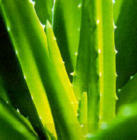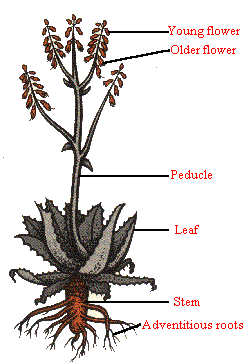
<< This Information found at http://www.herborganic.com/HerbGuide/aloe.htm >>
 Personality: Aloe is a fleshy, shallow rooted plant, tolerant of a wide range of conditions. With plenty of light and in well drained soil it grows quickly. The leaves change colour, from an insipid yellow-green, with too much water and too little light, to a darker, reddish hue in full sunlight .It is a highly attractive houseplant which multiplies freely.
Aloe - Aloe vera
Sources: Aloe is easy to grow from an offset obtained from a friend or a small plant bought at a nursery. Water it sparingly and give it plenty of light and you will soon have leaves large enough to harvest. You can also buy the juice, either dried or in stabilised liquid form, from health food shops.
Anecdotes: I keep a large Aloe plant in our conservatory as a sort of living first aid kit. The fresh juice can be squeezed from a leaf and applied to sunburn or minor burns. It has produced lots of baby plants which I break off as gifts for friends.
Uses & Actions: Aloe has two distinct types of use. Externally, it is applied, wherever healing and soothing are needed, especially with burns, stings and sunburn. Near the base of the leaves one finds a substance (bitter aloes) which should not be applied externally, but which is used as an internal remedy. Bitter aloes is generally stimulating to the digestive system and other areas of smooth muscle. Large doses are used as a laxative, but may cause cramping.
Preparations and dosage: For external use, it is best to scrape the gel out of a leaf and use it directly, or for small areas, just break open a leaf and apply it to the skin. A few drops of tincture in water will be sufficient to stimulate the appetite. For internal healing use the stabilised juice, at the recommended dosage.
Safety: Bitter aloes should not be taken in pregnancy, as it could over-stimulate the uterus. Do not use whilst breastfeeding as the action will reach the baby via the milk.
|
